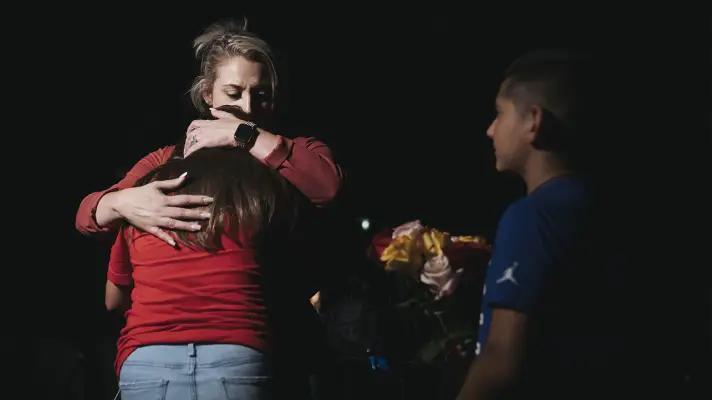Eric Thayer/Bloomberg via Getty Images
By the end of the day on May 24, more than 400 children walked out of Robb Elementary School in Uvalde, Texas as survivors. That single day of elementary school will follow them for years a formative trauma that increases their risks Experiencing depression, missing out on school, and even making less money over the course of their lives. Research shows that classroom violence harms children, regardless of whether they are physically harmed.
More than 50 million children were also enrolled in other K-12 schools across the United States that day. Whether they’ve been across town or across the country, many of these children will also have memories of May 24, 2022; Sirens, blaring messages, or the muffled, tense whispers of adults. They know something terrible has happened to children like them. Next year they’ll be doing active shooter practice in their own schools, reminding themselves that someday this will be real to someone, even if it’s never real to them.
Is that also some kind of trauma?
Precious little is known about how the impact of school shootings is on children in the rest of the community, state and nation. But there is plenty of research to suggest that the trauma of violence in general is unlikely to end in the specific place where it happened. And that, experts told me, means we need to think differently about the harm that violence can do and who is at risk.
Despite the high-profile nature of school shootings, and mass shootings more broadly, the mental health impact of these types of events has not been extensively studied. Five years ago, Dr. Sandro Galea, an epidemiologist at Boston University School of Public Health, co-published a review of research on how mass shootings affect mental health. The 49 peer-reviewed papers he analyzed focused mostly on what happened to direct survivors — people who were at the scene of a mass shooting but survived. There were few that dealt with indirect exposure.
These studies found evidence of trauma even among those who were not in the room or building where a mass shooting took place, although the closer people were to the actual incident, the greater the impact. Other factors — like media exposure or the time someone spent talking to family and friends about the shooting — also seemed to have an impact on who got away with trauma symptoms and how severe they were. But the amount of research on the subject has been very small and incomplete, and it’s hard to say much with certainty.
And according to Gaelea, that’s still true today. “The problem of the mental health of community members who aren’t directly affected … most people in the mental health field think it’s a real problem, but very little research has actually been done on it,” he told me.
More broadly, there is ample evidence that people in certain situations can be adversely affected in their mental health by traumatic events, even if they were not personally in physical danger. “We’ve known that for 20 years Viewing media images of suffering people can in and of itself be a trigger for common mood disorders, things like depression and post-traumatic stress,” Galea said.
Evidence suggests there are multiple types of indirect trauma, said Jennifer Carlson, a professor of sociology, government and public policy at the University of Arizona. Vicarious trauma, she said, is what happens when people like it Social workers are deeply exposed to the trauma of their clients and feeling helpless to prevent these people from experiencing traumatic events. Community trauma, meanwhile, occurs when entire populations are affected collectively traumatized by something that affects everyone on a cultural level, even if some do not experience it personally. The traumatic impact of the Holocaust on the Jewish community is a good example of this, as is the collective trauma expressed by Black Americans following the murder of George Floyd.
This knowledge has implications for how we think about the trauma of school shootings, although we don’t know exactly how school shootings affect children’s mental health nationwide. People who are not physically affected by a disaster are often reminded that they have a low risk of experiencing it themselves. Tens of millions of children start school every year, but only a little over a hundred a year – if ever – become a direct victim of a school shooting. The risk is low.
But that’s the wrong way to think about risk when we know a traumatic event is about to happen. The number of school shootings involving active shooters each year is very small — an average of 5 per year between 2021 and 2011, according to the Naval Postgraduate School’s K-12 School Shooting Database. But you have to go back to 1981 to find a year without at least one. School shootings are almost guaranteed to happen every year — we just don’t know to whom, Carlson said.
And that means that the risk of injury isn’t just about the physical likelihood of being shot, it’s also about it Anticipating a trauma that will happen to someone – maybe even you – and feel powerless to stop it and at the mercy of chance. “I’m a crime sociologist,” Carlson said. “I’m very on board with [the idea that] People overestimate their likelihood of becoming a victim.” But this is different, she said. The likelihood of anticipatory trauma can be high even when the risk of injury and death is low.
Given that, telling people not to be afraid of anything like gun violence is pointless. It’s not just about the personal risk of being shot, Galea said. In 2016 he published an analysis that found the likelihood that an American will ever know a victim of gun violence in their lives are almost 100 percent. There is a greater social burden than direct risk statistics can show.

